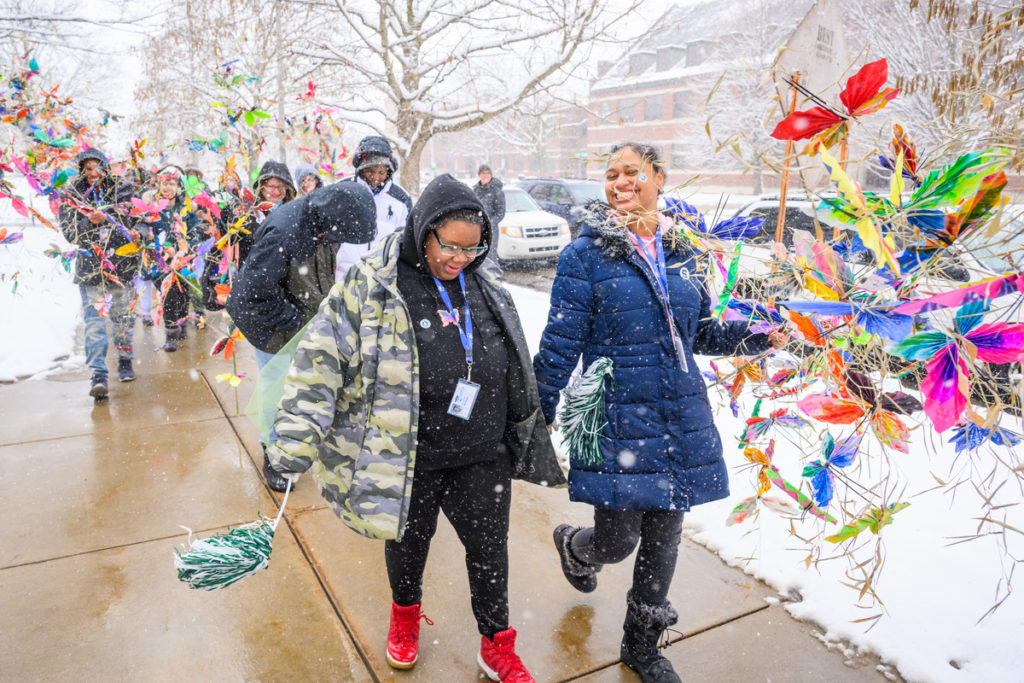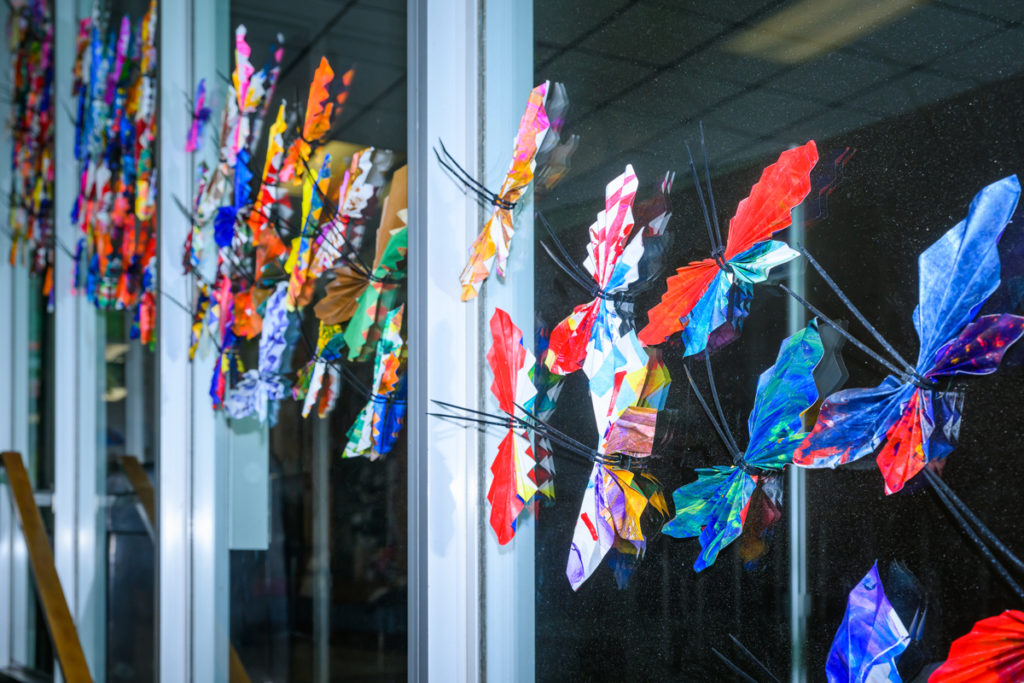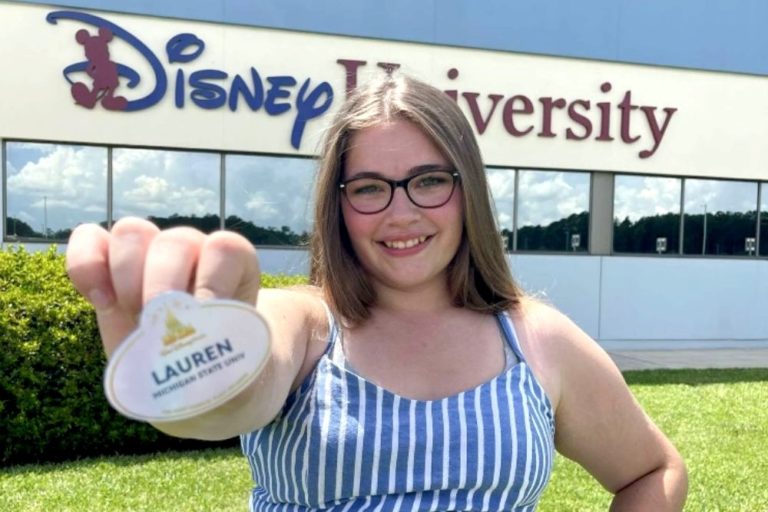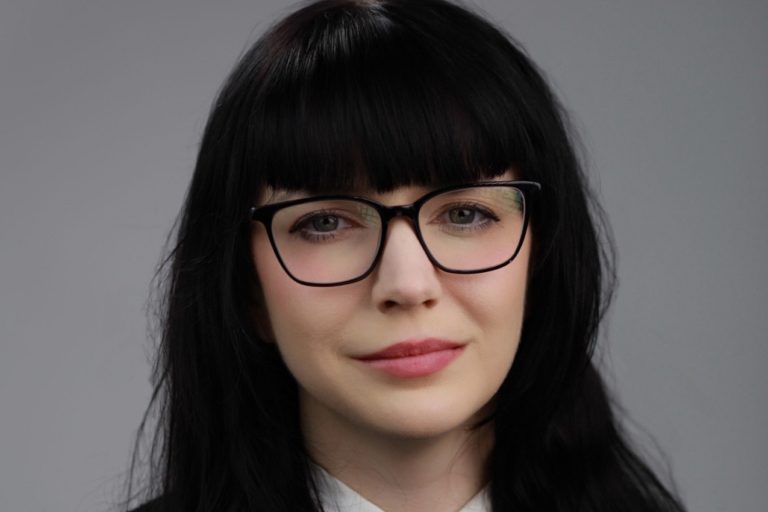Butterfly-making inspires solidarity, resilience, and community
This story refers to recent acts of violence at Michigan State University that may be difficult to read. Resources and assistance are available through multiple campus programs.
Mariko Kawaguchi is an Instructor of Japanese language in MSU’s Department of Linguistics, Languages and Cultures. Inspired by a 2022 art installation featuring thousands of origami butterflies created by MSU’s AgeAlive program in the College of Osteopathic Medicine, Kawaguchi envisioned the positivity such an exhibit could provide at the International Center on campus.
On March 13, members of the MSU community gathered at the International Center on campus for the installation of the butterfly garden exhibit “Together We Heal, Grow and Soar,” featuring folded-paper butterflies.

What inspired you to partner to create the butterfly garden art installation “Together We Heal, Grow and Soar”?
I learned about AgeAlive’s butterfly gardens by sheer chance. In April 2022, I went to an MSU Federal Credit Union location and ended up jotting down a calculation on one of the branch’s promotional materials. That card featured an MSU AgeAlive butterfly garden exhibition at the MSUFCU headquarters. A friend of mine has a daughter gifted in making origami, so I previewed the show mainly to see if I should recommend it to them. I was stunned by its beauty. I felt somewhat familiar with the art because origami is from my country, yet I was awed by the exhibit’s unique adaptation of it here in the United States.
After seeing the exhibit, I had a vision in which my students — those who couldn’t have the fullest experience during the COVID-19 pandemic — turned into butterflies and flew to Japan or anywhere they wanted to realize their dreams. That’s why I contacted the artist Zahrah Resh about creating a garden at the International Center. Zahrah is AgeAlive’s Artist-in-Residence and designs each garden, guided by the partner’s vision.
You took on a leadership role for this project. What did that ownership mean to you and how did it influence the outcome?
Taking on this project with AgeAlive, on top of my regular job responsibilities, was like having two full-time jobs. I faced roadblocks when I didn’t receive positive responses from everyone. However, I wanted to prove that anyone at MSU who works hard on a good project for a good cause can make a difference. Also, I met many wonderful people, including the AgeAlive team, through this project. Working with passion and making connections with new people were the keys to the project’s success for me.
Did working on this art installation project affect or influence your approach to teaching your Japanese language courses or vice versa?
My students served as a major inspiration for the creation of the butterfly garden. It gave them opportunities to learn about origami, connect with each other, and serve the community in a new way. For many of them, it was their first time doing origami. The art process provided them with a new insight to their studies about Japanese language as a culture.
My students served as a major inspiration for the creation of the butterfly garden. It gave them opportunities to learn about origami, connect with each other, and serve the community in a new way.
At the same time, teaching Japanese language and leading the project has been a lot to undertake. But, I had help from many talented individuals, without whom this garden would not have been possible. For example, a student of mine is an alumna from a local school district, so the two of us visited the school to facilitate one of the many butterfly-holding sessions that had been going on since this fall.
What is the importance of such an exhibit at MSU?
As the COVID-19 pandemic comes to an end, this exhibition is an excellent opportunity to celebrate coming out of the pandemic. From top leadership to the staff who cleaned and sanitized buildings, everyone had a challenging time, but we have navigated through it together.
Then the violence that our campus experienced on Feb. 13 gave us yet another reason to present this exhibition. People are still hurting and yet, kind actions are taking place. The garden’s 200-plus green and white butterflies, which people created after the tragedy, is one example. I hope the garden will help people heal.

One of the garden’s themes is to showcase Japanese and Asian solidarity and resilience. How important is that message for our campus community, and how do events like this one help combat discrimination?
On a personal level, being involved with this project gave me the strength to fight against discrimination toward Asian and Asian Americans. My campus-adjacent house has been vandalized a few times, and I can’t shake the feeling that I’ve been targeted because of my race. At midnight when I take my dog out to the front yard, I’m a bit afraid someone might attack me, especially when I hear news of hate crimes toward Asians and Asian Americans. Discrimination will happen from time to time, but the positive experiences of the butterfly garden project will continue to encourage me. I hope the garden will encourage other people of Asian ancestry, and that, together, we will make our society a better place.
On a professional level, as an Asian faculty member whose first language is not English, I regard myself as a reliable member of a group, but not as a leader — and perhaps many people share this notion about their Asian team members. I hope this exhibition shows one example of Asian leadership and conveys that we can lead important projects and share our culture and knowledge proudly. I also hope to send a positive message to anyone not confident with a leadership role because of their attributes or circumstances. Give it a try! You can do it!

The exhibition’s recent parade was designed to encourage healing following the violence our campus experienced Feb. 13. Can you explain how the exhibit promotes healing and well-being?
Seeing and touching beautiful paper butterflies tied to the natural bamboo stalks is healing. I wanted participants to literally feel the power of art. Also, connecting with other people is essential to one’s well-being.
During the butterfly-making sessions, participants met with people of diverse ages, backgrounds and affiliations, which created this positive vibe of collective goodness with people coming together to work toward a shared cause. I wanted people to experience that during the parade too.
What is one thing you hope people will take away from the exhibit?
The project’s name is “Together We Heal, Grow and Soar.” We hope the butterfly garden lightens peoples’ sadness and frustration, reaffirms their sense of gratitude, and strengthens their hope and commitment to the future.
MSU recognizes Asian Pacific Islander Desi American, or APIDA, Heritage Month during March and April each year to increase the visibility and awareness of the group’s multicultural diversity. For information on events, visit msutoday.msu.edu.
Written by Brigita Felkers – Original story published by MSU Today, March 22, 2023


